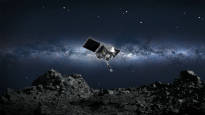This is the first batch of samples brought from the surface of an asteroid by NASA and the largest batch of samples brought from space since the Apollo missions.
The US space agency NASA’s Osiris-Rex probe returns to Earth today from its seven-year journey in space. The probe drops rock samples from the surface of the asteroid onto the Earth’s surface.
Osiris-Rex was launched into space in September 2016 and arrived in late 2018 in orbit around the asteroid Bennu. Bennu is an asteroid with a diameter of about 500 meters, which was discovered in 1999. It orbits the sun hundreds of millions of kilometers from Earth.
Bennu is classified as a potentially dangerous asteroid, as its probability of hitting Earth is 1:1,800 between 2178 and 2290.
After surveying the asteroid from orbit to find a suitable sampling site, the probe would pass by Bennu’s surface in October 2020. The landing area was only 16 meters in diameter, and Osiris-Rex’s collector touched the asteroid’s surface for less than 16 seconds. It collected approximately 400 grams to one kilogram of stones and dust.
Bennu was revealed to be different at close range than when viewed through telescopes. Its surface was not even smooth, but full of pebbles. In addition, the surface of the asteroid was not very solid in structure, but more like a sea of spheres.
An ancient asteroid
It is hoped that the samples will provide new information about the history of the solar system and the Earth. Bennu was chosen as a research target because it is a very old asteroid whose structure is estimated to have been relatively unchanged for billions of years. Bennu is believed to have formed during the first 10 million years of our solar system’s existence, more than 4.5 billion years ago.
The asteroid also has a lot of carbon, and on its surface you can find, among other things, molecules that were already present when life first began to form on Earth.
Osiris-Rex drops the capsule containing the samples in the Utah desert at the armed forces training area in the early evening Finnish time. The rest of the probe will remain in space for the next asteroid flyby. NASA’s landing broadcast starts at 5 p.m. Finnish time, and NASA’s press conference is at the turn of the day.
This is the first batch of samples brought from the surface of an asteroid by NASA and the largest batch of samples brought from space since the Apollo missions. Japanese probes have previously brought samples from two asteroids.
From Utah, the samples will be taken to the Johnson Space Center in Houston, and scientists around the world are eagerly awaiting the results.
